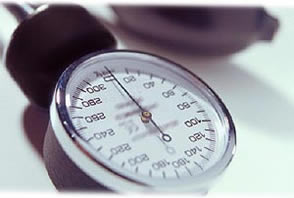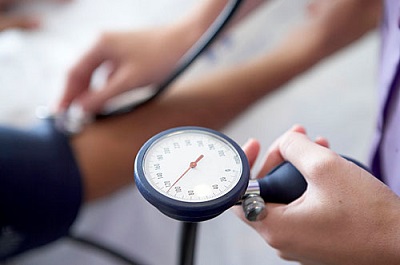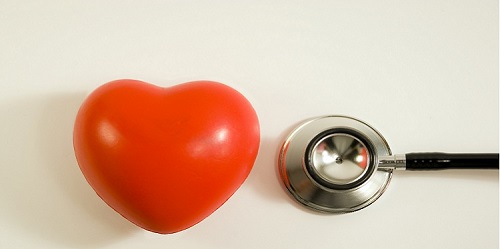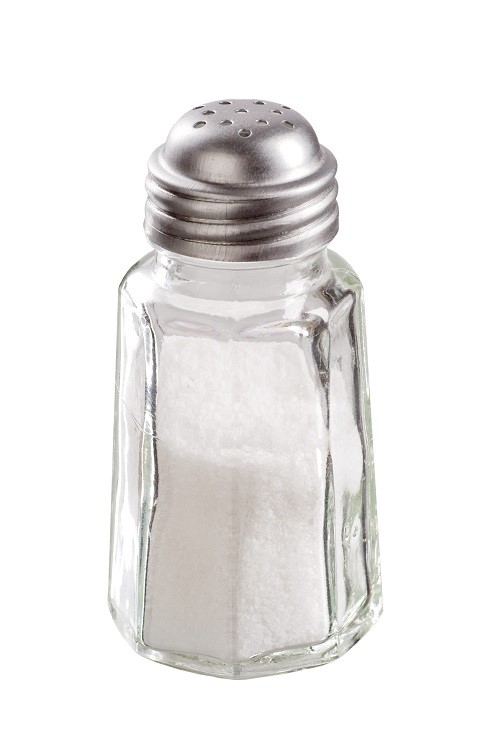High blood pressure
Introduction

At some point, we have heard a patient coming out of the doctor's surgery saying,
“I have the terribly expensive pressure!”
Making good use of this colloquial expression, we have launched our slogan:
“You are in the clouds?” to initiate a programme of health promotion on the blood pressure control, directed to all the workers of the company and coordinated by the Service of Mutua Universal's Occupational Medicine.
Definition and limit values
Blood pressure (BP) is the force with which the blood circulates through the arteries in the body. The higher the force, the weaker the arteries become and then they deteriorate.
Out of the two figures given in a BP reading, e.g. 160/90, the first and higher one corresponds to the systolic arterial pressure (SAP) and it indicates the pressure level that the arteries resist when the heart contracts and pumps the blood. The second figure, the diastolic arterial pressure (DAP), indicates the minimum arterial pressure when the heart relaxes. According to references of the World Health Organization, above 140 and 90 in a maintained way hypertension, any is considered type of hypertension is a cardiovascular risk factor.
The primary cardiovascular risk factors are: the tobacco use, the high blood pressure (HTA), the rise of total cholesterol in blood, diabetes, the obesity, the sedentary lifestyle, etc.
Cardiovascular risk factors are modifiable by applying therapeutic measures, and as a result of this, you can decrease the risk of illness.
The big problem of HTN lies in its very nature: it is a chronic process and silente that it can be asymptomatic or only to produce minimum symptoms lots years after its beginning, is for this reason that the general town owe measure regularly the pressure for its early detection.
HTN can be classified according to its etiology as follows:
- HTA essential: 95% of cases in which the cause is unknown
- HTA middle school: Remaining 5%, secondary to other pathologies
The origin of the majority of cases of hypertension is unknown, but there are habits and factors related to HTN that are modifiable, such as our lifestyle.
Detection

To detect the HTA in a precocious way, would be recommendable that you did you a “small examination”, that is, you propose that you take you the PA at the consulting office of the practitioner or that one of nursing of your outpatient department, or in the drugstore, since the majority theirs have a measuring equipment of PA, or, yourself in the case that you have the device of PA.
You must take into account standards for the PA's correct measurement described in the previous section.
Procedure
It carries out the measurement of the PA. If the figures are:
- Lower than PAS: 140 and DAP: 90 - -> secures to take a healthy life (to practice physical exercise, not to smoke, not to abuse of the alcohol, etc.) and it carries out annual controls of PA.
- Higher than 140/90, repeats the measure two days more:
- If these two days securities have been normalised, secures to take a healthy life and it carries out annual controls of PA.
- If these two days PA's figures remain high above 140/90 must apply the non pharmacological processing (annexe 2 and 3) during two months and to carry out PA's controls every fifteen days.
After two months of non-pharmacological treatment:
- If applying the processing PA's securities have been normalised, constant applying it, and it repeats PA's controls with a monthly frequency.
- If PA's securities persist high, you must get in touch with your family doctor so that it considers the need of establishing non pharmacological processing.
In any case, provided that in a measurement they appear securities higher than 180/110, enquiry with your family doctor.
If you take the pressure your same, is significant to remember that the PA of any individual is not a fixed value throughout the day, but instead that is subject to constant variations and is modified for numerous circumstances, which is why a better estimate is obtained when several measures are made.
To take a BP reading correctly, follow these recommendations:
- Do not take the reading just after eating or after intense physical exercise.
- Do not take the reading when you are in pain or stressed.
- Go to the toilet before taking your BP.
- Do not drink coffee, alcohol or smoke one hour before taking your PB.
- Sit down for at least five minutes before taking the reading in an atmosphere that is relaxed, quiet and at a comfortable temperature.
- Sit in a comfortable, relaxed position, with your back resting against the back of the chair and do not cross your legs.
- Will be made two readings separated by a time interval of at least two minutes.
- Take medicines or substances into account that you may be taking and may have an effect on your blood pressure.
Study

With the aim of assessing the percentage of working population that suffers this risk factor and the healthy town (not hypertensive), request that ALL employees that thus you wish it, reply the questionnaire that you attach and you send it by mail internal to the Medical Service of Mutua Universal (no. of centre 7053)
If the figures are lower than 140/90 after taking your BP, please fill in your personal details and the box for the first day and that is the end of the questionnaire. If your BP levels are above 140/90, get your blood pressure taken again for two more days, send us the questionnaire and start to apply the non-pharmacological treatment. Repeat the questionnaire two months after starting this treatment and send it to us again.
Data relating to the questionnaire will follow the provisions of the general and personal Data Protection Act, Organic Law 15/1999, and, through this same Law, you can demand access, opposition, cancellation and rectification of the data at any time.
FAQs

What is the HTA?
It is the continued elevation of the systolic and diastolic blood pressure figures. A person is hypertensive when it has repeatedly an identical blood pressure or above 140/90 mmHg.
Who does it affect and why is it important?
It affects around 20% of the adult population. This percentage increases with age. HTN affects both men and women, but it is more frequent in women after the menopause.
It is important because HTN increases the risk of suffering heart, kidney, brain and arterial vessel diseases.
How do we know if a person has high blood pressure?
We must remember that HTN does not give symptoms.
To be diagnosed as hypertensive, one BP measurement is NOT enough.
You must measure you the pressure in different visits consecutive. To do the diagnosis of HTA all PA's securities must be high.
Why is treatment necessary?
Because to go down the blood pressure avoids the appearance of cardiovascular diseases as a coronary, embolism or brain hemorrhage.
It is necessary to reduce and maintain our blood pressure figures under 140 and 90 mmHg. In the case of diabetic patients, the figures have to be lower (under 130/85 mmHg).
How you can go down the PA?
By making the following changes to our lifestyle:
- Losing weight: Weight loss, particularly in obese people, decreases the BP. A reduction of 4 to 5 strong Kg already has repercussions favourably on the blood pressure.
- Reducing salt intake: We need to get used to enjoying our food with a small amount of salt. We have to avoid convenience foods, cold meat, tinned foods, salt-cured products, smoked products, etc.
- Doing regular exercise: If you do not practice no sport usually, would be recommendable that in a regular way, gave an avenue in double time during 35-45 minutes three or more days a week.
- Reducing alcohol intake: It is necessary to moderate alcohol consumption.
- Quit smoking: Tobacco is a cardiovascular risk factor. Giving up smoking and getting our BP taken regularly have a good affect on our health.
- Taking medication: Some patients just need to make some modifications to their lifestyle to reduce their PB. In others are not enough and it is necessary to turn to the administration of medicines. Do not stop taking!
- Any introduction of a new medication must be authorised by a doctor.
- Make sure that you understand the dosis, frequency and time to take your medication correctly before taking anything.
- It is significant to take the medication always to the same time, thus oblivions are decreased.
- Get in touch with your practitioner or nurse before the appearance of any problem that it can relate with the takeover of medication.
How often do we need to get our blood pressure taken?
This is very variable and depends on the blood pressure readings, other diseases, etc. In the case of good control, a visit every 3-6 months is enough. It is necessary to have a medical checkup every year.
It is very important to measure your blood pressure regularly. It is the best way to avoid complications.
Food

Foods high in sodium (to avoid)
- Salt
- All cold meats
- Foie-gras
- All convenience foods
- Bacon and duck meat
- Canned, smoked and salt-cured fish and herring
- Viscera
- All seafood and shellfish
- Powdered milk and condensed, hard cheeses and “quesitos”
- Store-bought cakes
- Chard and fennel
- Salted nuts
- Olives
- Commercial sauces (mustard, ketchup, etc.)
- All tinned foods
- All fizzy drinks
- Crisps, snacks, etc.
- Baking soda and antacids with sodium
Food low in sodium (preferred)
- Meat of veal, cow, chicken and rabbit
- Eggs
- All fish (excluding what is not recommended)
- Milk, yogurs, fresh cheeses, unsalted butter, etc.
- Homemade cakes without salt
- Asparagus, Brussels sprouts, peas, potatoes, cauliflower, radishes, etc.
- Pulses
- All nuts (without salt)
- Homemade sauces without salt
- All fruit
- Natural juices
